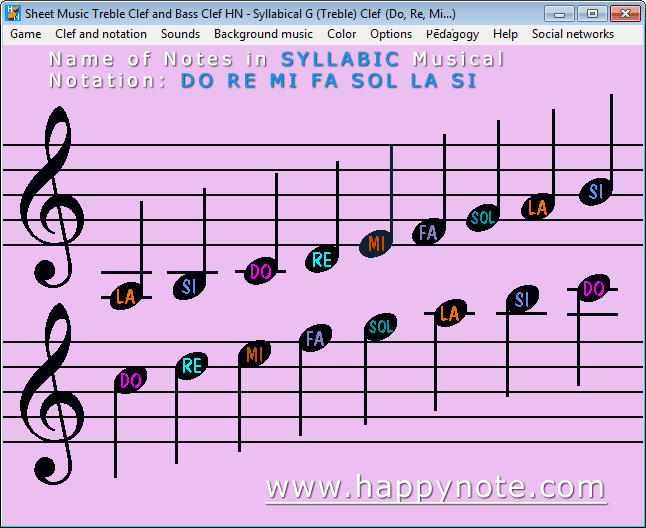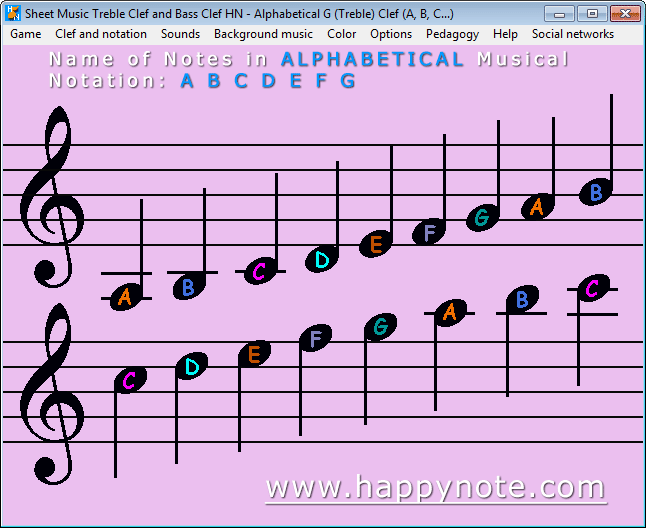Welcome ! Here you will find all the necessary information about the music note, a musical symbol used to express the pitch and duration of a sound.
You will also learn about two ways to name the notes, either by using syllables – DO RE MI FA SOL LA SI/TI – or by using letters – A B C D E F G.
SHOW/HIDE TABLE OF CONTENTS
Each Musical Note on a Score Indicates a Pitch and a Duration of the Sound
The pitch of a note is indicated by its position on the staff and the clef placed at the beginning of that staff. The higher a note is placed on the staff, the higher the pitch will be. Conversely, the lower it is placed, the lower the pitch will be.
Its duration is expressed by the shape of the note.
The Clefs and the Place of the Note on the Musical Staff fix its Name and its Pitch
The name and pitch of each musical note is determined by its position on the staff…

…and by the clef placed at the beginning of the staff.
The Treble Clef (G Clef)
The Bass Clef (F Clef)
The C clef (alto clef, tenor clef)
Thus, with a treble clef, a note placed on the fifth line of the staff – counting the lines from bottom to top – will correspond to a midrange F (FA). While with a bass clef, it will correspond to an A (LA) that is almost two octaves lower (an octave is an interval of 8 notes separating two notes of the same name).
You can learn about the treble clef (G clef) by watching the video below:
And you can learn about the bass clef (F clef) by watching the following video:
7 Notes of Music and Two Systems to Name Them
There are seven notes of music and two different systems to name the music notes: A B C D E F G and DO RE MI FA SOL LA SI.
The Syllabic Musical Notation: DO RE MI FA SOL LA SI (TI)
The origin of the syllabic name of the music notes is attributed to the Italian monk Guido d’Arezzo, who in the 11th century used the first syllables of a Latin hymn from the vespers liturgy of the Feast of the Nativity of Saint John the Baptist, “Ut queant laxis,” to name each music note:
Ut queant laxis
resonare fibris
Mira gestorum
famuli tuorum,
Solve polluti
labii reatum,
Sancte Iohannes.
This yields, for the first six verses: UT – RE – MI – FA – SOL – LA
It was only at the end of the 16th century that the note SI, using the initials of the last verse, was added.

Furthermore, the musical note UT, the only one to begin with a vowel, was partially replaced by DO in the 17th century, which is easier to pronounce when reading the names of the notes aloud.
How to Read Music Notes with DO RE MI FA SOL LA SI/TI?
For the treble clef (G clef), you can try watching the 4K video below to learn how to read the note MI in just 1 minute…
…or you can check out the step-by-step playlist of 16 videos in 4K on YouTube.
For the bass clef (F clef), you can also learn how to read the note MI in just 1 minute…
…or you can check out the step-by-step playlist of 16 videos in 4K on YouTube.
TI and Hollywood
In English-speaking countries during the nineteenth century, Sarah Glover, an English music educator, modified the solmization syllables. She changed “SI” to “TI” in the Norwich sol-fa system to ensure that each syllable began with a unique letter. Additionally, she reserved “SI” for potential future use as “Sol-sharp”.
Ti is utilized in tonic sol-fa and in the famed American show tune “Do-Re-Mi” which was popularized by the Hollywood movie, The Sound of Music:

Ti, a drink with jam and bread…
The Alphabetical Musical Notation: A B/H C D E F G
There is another notation system primarily used in Anglo-Saxon countries (and therefore also in jazz), which employs letters of the alphabet to designate each musical note: A – B – C – D – E – F – G

This system dating back to antiquity has origins far predating the syllabic notation introduced by Guido d’Arezzo. The Roman senator and philosopher Anicius Manlius Severinus Boethius, or more simply Boethius, born around 480, is known to have assigned the first fourteen letters of the classical Latin alphabet to the notes of the two-octave scale used during his time.
Although Boethius is credited as the first writer to introduce this terminology into literature, Ptolemy had already mentioned it five centuries earlier when referring to the two-octave scale, which he called a perfect or complete musical system, unlike other more restricted scales.
How to Read Music Notes with A B C D E F G
For the G clef (treble clef), try the video below or check the playlist (16 videos) on YouTube.
For the F clef (bass clef), try the video below or check the playlist (16 videos) on YouTube.
You can also try the online game Read Music Notes HN: you can choose between treble clef and bass clef and A B C… and DO RE MI.
German Alphabetical Notation
The names of musical notes in German notation differ from the English system in two ways: the natural B (SI) or B♮ (natural) uses the letter H instead of the letter B, which is used for B♭ (flat):
A – H – C – D – E – F – G



